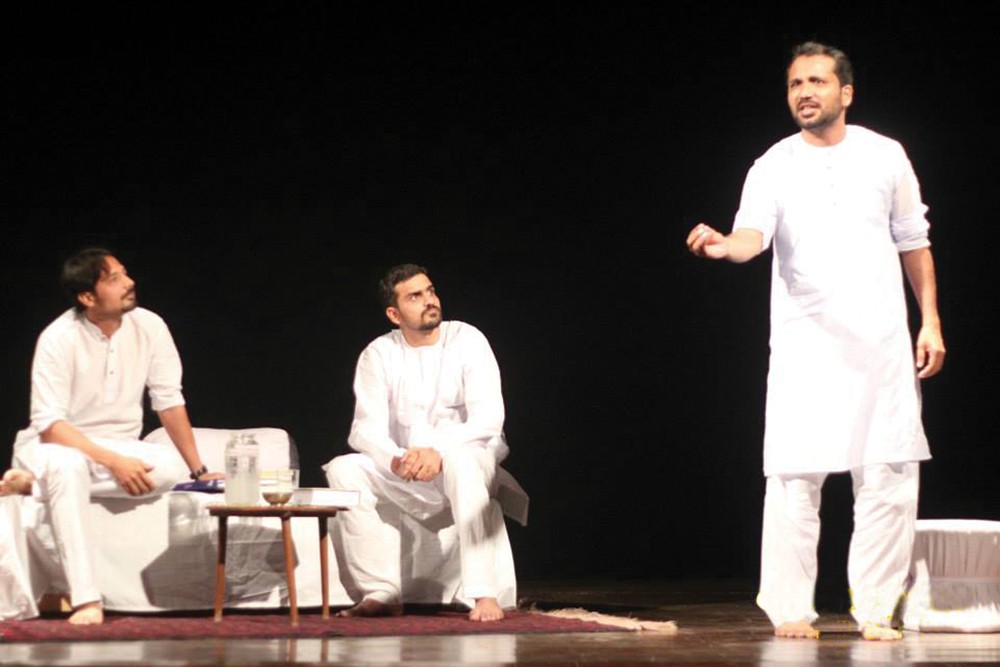
‘A Night of Literary Adventures’ was held at NCA, with a reading of Daastaan-e-Tilism-e-Hoshruba and Aab-e-Gum that spoke volumes of the organisers’ efforts to contemporarise daastaangoi

Harry Potter came and conquered the imagination of children and young adults all over the world. Yet, few are aware of the numerous features and ideas that Rowling had borrowed from the daastaan (tale) of Tilism-e-Hoshruba. The invisibility cloak, the poly-juice potion, the bottomless bag full of enchanted objects and the deluminator are just some of the magical innovations that the Tilism has gifted to the magical realm of Harry Potter.
Today, one witnesses a renewed interest in traditional arts that has inspired the revival of the Urdu daastaan and daastaangoi (storytelling). The effort is attributed to the Indian poet and critic Shamsur Rehman Faruqi and his nephew, writer-director Mahmood Faruqi. On this side of the border, recently, Lahore has seen a couple of daastaangoi events, organised by Olomopolo Media.
Whereas the initial daastaangoi events were held at their studio, in front of a select crowd, the encouraging response led Olomopolo to fashion a similar project for a larger audience at National College of Arts’s Shakir Ali Auditorium. It was ‘A Night of Literary Adventures’ with Daastaan-e-Tilism-e-Hoshruba and Aab-e-Gum.
The tradition of oral storytelling can be found in every ancient civilisation. Before there were pens, there were words. Long before the history of mankind could be recorded through the written word, storytellers preserved an account of their society orally. In the Asian region, it was better known as ‘Daastangoi’ and originated in Persia during the early 16th century. Indian anthropologist Ghaus Ansari has traced the trajectory of daastaangoi eastwards from Iran to Delhi, following the advent of Islam in the region.
Affected by the Indian Uprising of 1857, the exodus of writers and artists from Delhi led the daastaangoi art form to the other centre of cultural refinement and Urdu literature, Lucknow. Unfortunately, the rise in popularity of newer forms of entertainment soon relegated the subtle art of oration to a distant memory.
Daastaans have not simply been a chronicle of history. The earliest daastaans were characterised by the spirit of adventure. Elements of magical realism could be found in the tales of the daastaangos (story-tellers) much before Marquez popularised the genre. The tales borrowed freely from epics such as Arabian Nights and the animal fables of the Panchatantra.
With the spread of Islam in the region, the daastaans began to focus on the life and adventures of the Muslim leader Amir Hamza as he battled the forces of evil. Trickery, called ‘aiyyari’ by the Indian daastaangos, was introduced into Urdu tales and centred on the heroics of Umar O Aiyyar.
The strength of oral storytelling is not just in the story itself but rather relies upon the talent of the orator. Subtle variations in tone elevate a straightforward narration of events to the status of an art form. Telling a story is easy; the magic lies in recreating the ambiance of an era long gone.
Attired in crisp white kurtas, three theatre artists from Karachi transported the packed hall at NCA to the heyday of Urdu adab. Introduced by Meesam Naqvi, Fawad Khan and Nazarul Hasan took centre stage with an extract culled from Muhammad Hussain Jah and Ahmed Hussain Qamar’s translation of Daastaan-e-Tilism-e-Hoshruba.
With a plain white takht as their only prop, Khan and Hassan displayed the artistic power of nuanced speech. The wonder and admiration in their voices as they recounted Aiyyar’s boldness, was infectious. The turn of phrase in ‘Lakhnvi’ Urdu were delivered with such ease and intonation so as to transport the audience back in time.
The shift from one orator to the other was seamless and came across as the exchange of stories between two friends. The facial expressions and gestures of the storytellers mirrored the fantastical plot of their narrative.
The second piece in their repertoire was a selection from Mushtaq Ahmed Yousafi’s satirical masterpiece Aab-e-Gum. Yousafi is noted amongst Pakistan’s most eminent humourists and he is the recipient of the country’s highest literary honours -- Sitara-e-Imtiaz and Hilal-e-Imtiaz.
The daastaan from Yousafi revolved around the migration of the last great daastaango Mir Baqir Ali, from India to Pakistan. Simultaneously humorous and thought-provoking, Yousafi’s witty prose is a light-hearted commentary on the state of society.
The extract from Aab-e-Gum was a refreshing change and was selected by the Olomoplo team as part of an effort to contemporarise and expand the traditional scope of daastaangoi. The regular bursts of laughter from the crowd were an appreciative nod of approval towards the organisers’ choice of text.
The Olomopolo team, led by Kanwal Khoosat, is passionate about preserving Pakistan’s cultural wealth by reintroducing modern society to the uniqueness of their artistic heritage. It is hoped that their efforts to revive interest in the Urdu literature will not go unnoticed.